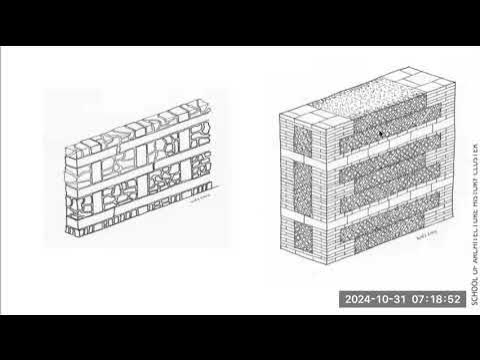Romanesque era furniture design
Summary
TLDRThe transcript delves into the Romantic architectural style, highlighting its emergence in the early 19th century as an evolution from Roman and Byzantine influences. Initially coined by archaeologist Charles De Gerville, the term describes a blend of ancient Roman aesthetics and Christian themes. Key characteristics include thick walls, rounded arches, and decorative elements, reflecting simplicity compared to Gothic architecture. The discussion extends to furniture design, emphasizing practical yet symbolic pieces like thrones, beds, and chests, which were integral to medieval homes. Overall, the Romantic style signifies a return to classic forms, characterized by curved lines and ornamental designs.
Takeaways
- 🏛️ The term 'Romance' was first applied by archaeologist Charles De Gervil in the early 19th century to describe architecture in Europe.
- 📚 'Romance' architecture emerged during the medieval period and is characterized by a blend of ancient Roman styles and Christian religious concepts.
- 🔄 The Romantic style evolved between the 9th and 12th centuries, reflecting a continuation of Roman architecture with distinct characteristics.
- 🕍 Notable features of Romantic architecture include thick walls, rounded arches, massive structures, and decorative elements.
- ⚒️ Artisans during the Romantic period often imitated ancient Roman works while integrating ideas from Christian architecture.
- 📏 Key characteristics include thick walls, circular forms, sturdy columns, and a combination of Roman and Byzantine styles.
- 🪑 Furniture design in the Romantic period saw a decline in craftsmanship, focusing more on practicality rather than luxury.
- 🖼️ Decorative elements in furniture and architecture featured simpler designs inspired by nature, such as plants and animals.
- 🛏️ Important furniture types included thrones for nobility, simple beds, and large chests that served as vital household items.
- 🔗 The Romantic style is marked by semi-circular windows and ornamental designs, emphasizing curves and circular shapes in both architecture and interior design.
Q & A
What is the romantic style in architecture?
-The romantic style, or Romance architecture, emerged in Europe during the medieval period, characterized by its massive structures, thick walls, and decorative elements, integrating ideas from Roman and Christian religious architecture.
Who first applied the term 'Romantic' to architecture, and when?
-The term 'Romantic' was first applied to architecture by archaeologist Charles De Gervil in the early 19th century to describe a style that preceded Gothic architecture.
What historical period does the romantic style originate from?
-The romantic style originated in the medieval period, around the 9th century, and it is believed to have lasted until the 12th century.
How did artists and architects of the romantic period approach their designs?
-Artists and architects during the romantic period often imitated ancient Roman works while incorporating ideas from Christian architecture, resulting in a blend of classical and religious design elements.
What are some key characteristics of romantic architecture?
-Key characteristics of romantic architecture include thick walls, circular arches, small windows, and an overall simplicity compared to Gothic styles, with decorative elements featuring biblical figures and nature.
What types of buildings were commonly constructed during the romantic period?
-Common buildings constructed during the romantic period included churches, cathedrals, castles, and city walls, reflecting the architectural styles of the time.
What was the significance of furniture design during the romantic period?
-Furniture design during the romantic period was simpler compared to earlier styles, often designed for church use due to decreased public interest in luxury furnishings, incorporating elements of nature and basic shapes.
What types of furniture were prevalent in the romantic period?
-Prevalent types of furniture included thrones used by nobles, simple beds, and large chests, often constructed from wood with iron accents, reflecting the functional needs of households in the medieval era.
How did the romantic period influence window design?
-The romantic period influenced window design with the use of semi-circular shapes and decorative arches, emphasizing a blend of aesthetics that aligned with the architectural style of the time.
What cultural aspects are reflected in the romantic architecture?
-Romantic architecture reflects cultural aspects such as the integration of religious beliefs, historical reverence for Roman design, and the societal values of the medieval period, emphasizing simplicity and functionality.
Outlines

هذا القسم متوفر فقط للمشتركين. يرجى الترقية للوصول إلى هذه الميزة.
قم بالترقية الآنMindmap

هذا القسم متوفر فقط للمشتركين. يرجى الترقية للوصول إلى هذه الميزة.
قم بالترقية الآنKeywords

هذا القسم متوفر فقط للمشتركين. يرجى الترقية للوصول إلى هذه الميزة.
قم بالترقية الآنHighlights

هذا القسم متوفر فقط للمشتركين. يرجى الترقية للوصول إلى هذه الميزة.
قم بالترقية الآنTranscripts

هذا القسم متوفر فقط للمشتركين. يرجى الترقية للوصول إلى هذه الميزة.
قم بالترقية الآنتصفح المزيد من مقاطع الفيديو ذات الصلة
5.0 / 5 (0 votes)






